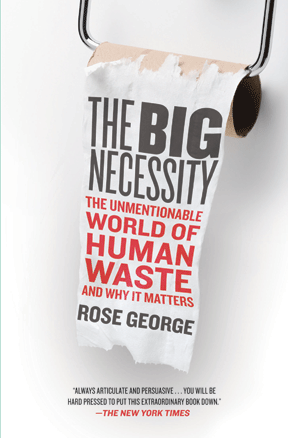
The Penn Reading Project is officially in the toilet. The program celebrated its 20th year by selecting Rose George G’94’s The Big Necessity: The Unmentionable World of Human Waste and Why It Matters as summer reading for incoming freshmen. George’s acclaimed exploration of the reality behind—and beyond—the flush lever dovetails with Penn’s Year of Water, a series of conferences, exhibits, performances, and other events sponsored by the provost’s office. In lieu of a book report, Gazetteassociate editor Trey Popp tracked down the globetrotting author by email to ask her about sanitation crises in the developing world, the sustainability of modern sewage systems, and the most memorable latrine she’s ever seen.
You live in a part of the world where people haven’t really had to think about toilets or sewage for more than a century. What jogged your interest in excrement?
I think in the Western, industrialized world, we actually spend more time thinking privately about toilets than you would expect. How many of us, for example, spend time strategizing about where we are going to find a public restroom when we’re out, or hiking, or on holiday? However, you are right in that we rarely do, and are rarely obliged to, give much thought to what happens to our excrement after the flush. Before I started taking an interest in this, I was probably like many people; I assumed it went somewhere and was magically cleaned. I didn’t give any thought to what happens to the sludge that is removed from the clean effluent (which is provoking a huge and thorny debate in the US, where it is most commonly applied to land as fertilizer). I didn’t know about nutrient overload, which is what happens when raw sewage is discharged into waters, and can cause dead zones in the ocean. I certainly didn’t know how much raw sewage is commonly discharged. Because sewer systems can be so easily overloaded, with a five-minute sharp rainstorm untreated sewage has to be released because there is nowhere to put it. In New York, that happens every week. Millions of gallons.
As for how I came to the topic, it was via a previous job, at Colorsmagazine, where we were tasked with producing a coffee-table, glossy book called Cacas. It had beautiful still-life shots of animal and human excrement, which weren’t to my taste, but the little texts we ran alongside the pictures were fascinating. I discovered that shit can be useful: as fertilizer, as bricks, as face-cream, even as jewelry (in Japan). But that was also when I learned the astonishing—to me—fact that a quarter of the world has no sanitation, and that diarrhea, which is overwhelmingly caused by excrement-contaminated food and water, kills more children than HIV/AIDS, TB, and malaria put together! I considered myself relatively well-educated and open-minded, but these facts were a total shock to me.
What’s the worst toilet you’ve ever encountered?
I’m often asked that, and I have various answers. There was the Chinese roadside latrine teeming with maggots, which was gruesome and made me angry—that people are supposed to put up with that. Or of course one of the worst toilets is no toilet, which is commonplace in most slums I’ve visited, and in much of the rural developing world. In case you think that means doing your business in peace and quiet in the woods somewhere, you are wrong. I’ve seen grandmothers forced to squat by the roadside in rural India because there were no latrines. They covered their face from the shame. Then there was the public restroom at the Happiness and Prosperity Service Station in China, which was probably the most memorable, as it was my first encounter with the fact that most public toilets in China, outside Beijing, have no doors. I’m still trying to find out why. I asked countless Chinese, and no one could tell me. The best answer to “Why don’t Chinese need doors?” was, “They just don’t.”
Is there a best one?
Again, that depends. The best toilet is the toilet that is most suitable to the context and to the people who are going to use it. Of course the super hi-tech robo-toilets of Japan are amazing. But for a Malawian farmer, a composting pit latrine, into which he can plant a banana tree when it’s filled, is equally amazing. Flexibility and appropriate sanitation are fundamental.
You cite a UN estimate that 2.6 billion people are toiletless. What’s the best-case scenario for their future, in sanitation terms? Are Western-style flush toilets a sustainable solution everywhere? Is water-based management of human waste even sustainable in the West?
Water-based management of human waste made perfect sense when it became popular in the 19th century. Water is a good carriage of our solid and liquid waste, and there was no understanding that the nutrients—nitrogen, potassium, phosphorus—that our excrement is packed with could be damaging to the water they were discharged into, which has a delicate balance of nutrients that can easily be upset. That said, when the great sewer system of London was installed in the 19th century, there were plenty of people who thought it was crazy to take solids, which are manageable, and mix them with water, thus making them much harder to deal with. Karl Marx thought it was daft to ruin all that potentially good fertilizer, and said London was throwing away £4 million a year.
Pure human waste—unmixed with chemicals and industrial products, as today’s sewage is—is perfectly good fertilizer. The Chinese have used it for thousands of years, and in the US and the UK it was common for night-soil men to collect a valuable resource. When we decided to use waterborne waste treatment, a resource suddenly became a waste to be dealt with. It was a psychological and cultural shift which many argue was very wrong. Not only is drinking water an increasingly limited resource, but the wastewater treatment paradigm—flush toilet, sewer, wastewater treatment plant—uses a lot of energy and money. It’s astonishing how few facilities make any attempt to recover the energy inherent in sewage—less than 100 out of 16,000 in the US!
So simply installing expensive and energy-consuming wastewater treatment plants in the developing world is not a solution, particularly in countries which lack the water or the skill-base to run them. The expensive World-Bank-funded plant in Delhi, for example, has pipes gushing uselessly into the Yamuna River, which is now dead. The key to solving the 2.6 billion toiletless is flexibility. There are all sorts of innovations and inventions, from composting latrines to urine-diverting toilets, that make more sense, particularly when our phosphate reserves—
crucial to make artificial fertilizer—are running out, too.
Are there better things we can do with human waste than send it down the pipes to sewage-treatment facilities?
Yes. It can generate electricity, fertilize plants, be used for cooking gas. One of my favorite trips in the book was to China, where deforestation in rural areas is a huge problem. Women had to spend hours every day getting firewood, and then hours cooking over a dangerously smoky stove. But with a biogas digester—an underground tank attached to the latrine that produces methane from excrement, which can then be used as cooking gas—they had a free and inexhaustible source of energy. There are 18 million digesters installed so far.
In the West though, our wastewater industry is not the most innovative. What is most crucial is to stop thinking of excrement as waste but as an untapped resource. I mean, if NASA knows this—because water is heavy, they recycle urine—then us earthbound [types] should be able to figure it out, too. Almost every society on Earth has adopted technologies like mobile phones and the Internet. What do you make of the fact that “the Big Necessity” remains an unsolved problem in so many of them?
I blame the flush toilet. Though it is a wonderful, life-saving invention—flush toilets and sewers stamped out cholera and other shit-borne diseases, and improved child health more than any other invention—it also meant that we could put it in a lockable room and flush it out of conversation.
It is simply scandalous that in 2010, children are still dying from something as banal as diarrhea, largely because of an unwillingness to address or fund this. And it is also plain stupid, because installing good sanitation will mean fewer children dropping out of school or dying; mothers who don’t have to spend hours searching for a private place in which to defecate, so they have more time to earn money; fathers who can work more because they are not sick, weekly, with dysentery or cholera. Financially, if you invest $1 in sanitation, you save $7 on hospital bills, lost labor days, et cetera. Sanitation is quite simply the most cost-effective health measure in existence. It is so appalling that it is still ignored by public figures, donors, and politicians.
Has studying the ways people deal with—or avoid dealing with—their excrement changed your view of human nature?
I realized how complicated humans are. I was so surprised to find that in some situations, even when someone is given a free latrine, they will choose not to use it. I actually met one man, a health worker in Himachal Pradesh, India, who was attending a workshop about using shock tactics to get people to install latrines. The trick was to get them to want a latrine, rather than be given one or told they should have one. Health professionals know that nagging hardly ever changes behavior. This workshop was teaching Community-Led Total Sanitation, which confronted people with the fact that if they have no latrines, then their children and adults and animals are tramping fecal particles back into the village, where they get into food and water. Everyone in a latrine-less village is probably eating feces every day. Anyway, this health worker went through the process and at the end ran up to me and said, ‘You know, I’m a health worker, and five years ago the government gave me a nice new latrine, and I never used it! I preferred to go and defecate by the river, in the fresh air. But now I realize that if I’m defecating near the river, someone else is drinking it.’ The thing is, he had known that all along, but had chosen not to see it. Only when someone else saw it did he realize and was shamed. He said he was going home right now to install his latrine and use it.




